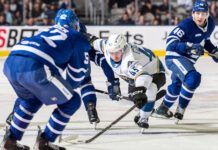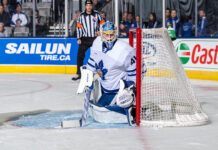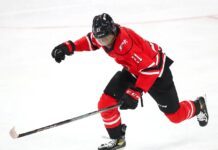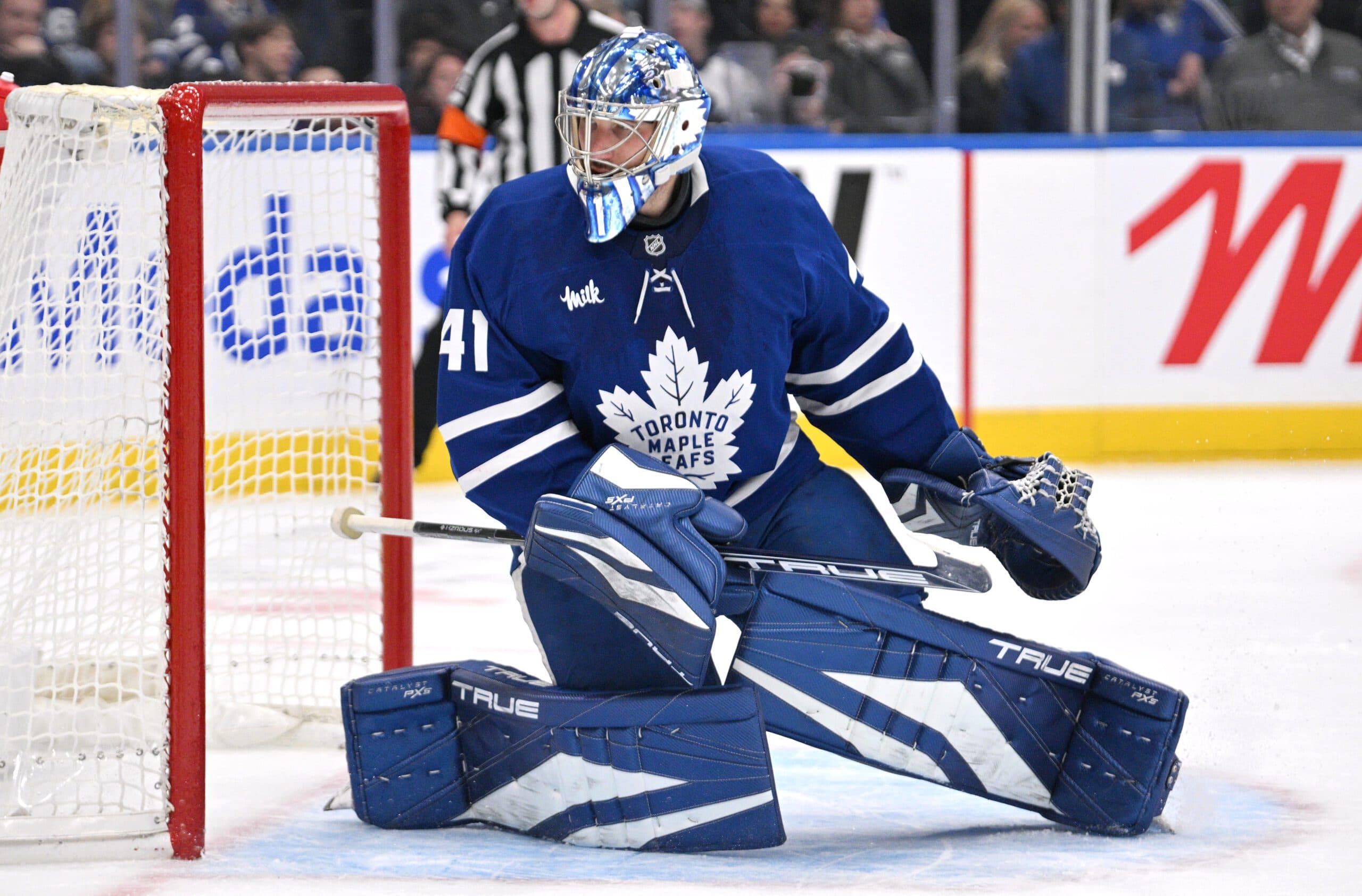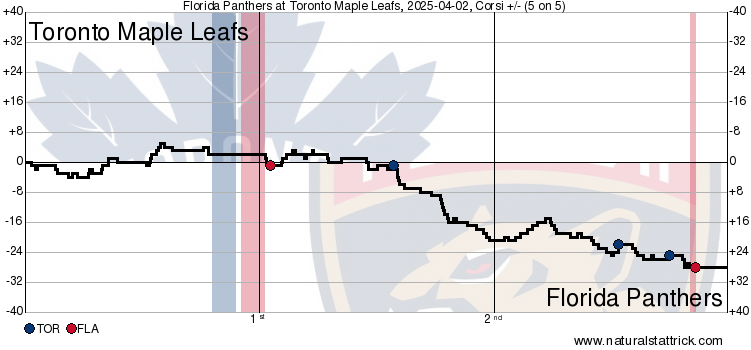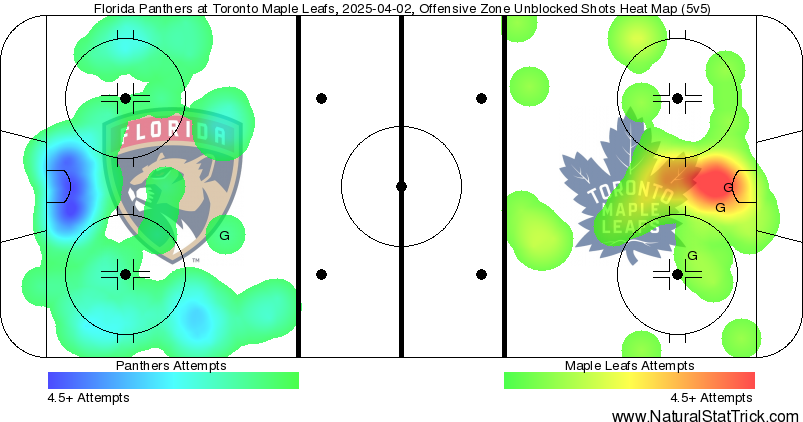The process wasn’t always pretty, but the Toronto Maple Leafs scratched out a pivotal regulation win over the rival Florida Panthers by a 3-2 score.
Against a heavily shorthanded Panthers team on the second night of a back-to-back, the Leafs played a strong first period but didn’t get rewarded before surviving a terrible second period with the game tied at 1-1. Two third-period goals from the first line, in addition to strong goaltending from Anthony Stolarz, helped put the game away, even if a late Florida power-play goal trimmed the lead to one.
With the regulation win, the Maple Leafs move four points clear of Florida as both teams have just seven games to play in the regular season.
Your game in 10:
1. Less than an hour before puck drop, we got word that the Panthers would be without star center Aleksander Barkov, in addition to the already injured Matthew Tkachuk and suspended Aaron Ekblad. When we factor in that Florida played last night in Montreal, the deck was stacked in the Leafs‘ favour.
That said, the Panthers were prepared for this game, starting Sergei Bobrovsky after going with backup Vitek Vanecek last night against the Habs, a decision that might have cost them a point after Vanecek misplayed a wrap-around goal in overtime. The Leafs went with line combinations we have been familiar with in recent games — Nick Robertson was scratched among forwards, while Philippe Myers remains the first defenseman out — as the lineup remained the same from the win in Anaheim.
The game started rather sleepily, with both teams feeling each other out over the first 3.5 minutes. There weren’t many shots or chances in either direction. The one line that stood out in the early going for the Leafs was the second line of John Tavares centering William Nylander and Bobby McMann, who generated one shot on net on each of their first three shifts of the game, including Toronto’s first real scoring chance (a Nylander pass to set up McMann in the slot).
The first line eventually got in on the action when Matthew Knies set up Auston Matthews all alone in front of the Florida net, but Bobrovsky had an answer for the Toronto captain. It was a decently productive first 10 minutes for the Leafs, but they couldn’t break the ice.
2. The Florida neutral-zone forecheck stood out as an early problem for the Maple Leafs and continued to be as the game wore on.
In the first period, there were several instances of Florida defensemen stepping up aggressively in the neutral zone and undercutting the Leafs’ passes, which were at times overly stretched out on their breakouts. The Leafs struggled to enter the offensive zone with possession outside of counter rushes where a forward snuck behind a defenseman (this would come up once rather memorably later in this game). With the game bogged down in the neutral zone, the Leafs were coaxed into several sloppy icings in the first period as they tried to deal with the Florida pressure around center ice.
Toronto generally had the puck enough in the first period and generated the better scoring chances, but issues in the neutral zone foreshadowed challenges later in the game when Florida started crisply breaking out of their own zone and tilting the ice in their favour.
3. The first period ended with a pair of power plays for the two teams in rapid succession. Florida was called for interference on Uvis Balinskis, shadowing a Leaf forechecker and getting in his way, the sort of gentle interference that the Panthers often get away with.
The Maple Leafs went to the power play, generally held the zone, and ran identifiable plays, but Florida’s penalty kill was impressive. Seth Jones and Gustav Forsling both made diving blocks on attempted Maple Leaf passes to the back door, in addition to other shot blocks by the unit. It wasn’t a bad PP opportunity by the Leafs, but it didn’t open the scoring.
Florida’s power play came with a bit of carryover time. Chris Tanev was called for clipping Brad Marchand up high with his stick and headed to the box, a double-whammy for the Leafs as they were about to be shorthanded without their best defensive defenseman for the kill.
Anthony Stolarz was forced to make one nice save, but nothing else was terribly threatening before the first period ended. The two teams were tied, but the Maple Leafs played a solid period. There were challenges they needed to solve, but they slightly outplayed a team they should’ve been outplaying at five-on-five.
4. The Panthers weren’t able to score on the carryover power play, but the Leafs never got a change after the game returned to five aside; in fact, they never even cleared the puck.
Hemmed in, Toronto’s top PKers — Matthews, Marner, Tanev, and McCabe — could not break the Panthers’ cycle for an extended period. Seth Jones kept it alive and then teed up Gustav Forsling for a slap-shot from the point with a straight-on angle at Stolarz.
It was a good, hard, high shot, but it wasn’t tucked in the corner, and the Leafs’ goalie saw it with no screen and shakily waved his glove at the puck as it whizzed by him. While the Leafs were generating good looks at Bobrovsky to no avail, the Panthers took the lead on a saveable shot.
5. The difference in the game at 1-0 might’ve been Florida’s superior goaltending, but it soon flipped as the Panthers solidly outplayed the Maple Leafs in the second period.
In fact, that may be a bit of a generous description of how bad the middle frame was for the Leafs. In a period played nearly in its entirety at five-on-five, the Leafs were out-attempted 33-10 at even strength. Shots on goal were 15-6 in favour of the Panthers, scoring chances were 17-7, and high-danger chances were 6-4, all via Natural Stat Trick.
The problems for the Leafs in the second period were a combination of the aforementioned troubles in the neutral zone, compounded by Florida beginning to execute crisper breakouts. The Panthers were a far more structured hockey team in the second period with the long change — as shown in those aforementioned middle-frame numbers — as they broke out in harmony in five-man units. The Leafs re-encountered their off-and-on struggles from the second half of this season when it came to breaking out cleanly (or too frequently defaulting to dumps/flips out) and setting up a real forecheck.
When they weren’t just dumping and changing, the Leafs were largely unable to get through the neutral zone cleanly and made little progress on the forecheck off of their dump-ins beyond light pressure from F1; the Panthers were headed right back the other way out of the zone. Florida had no trouble slicing through Toronto’s NZ forecheck and gained the blue line with ease in the second period.
As for the in-zone defense, the Leafs were too content to pack it in, with their skaters huddling in the dangerous areas and letting the Panthers cycle around them. It is true that Florida didn’t get a huge number of Grade-A looks, and the Leafs — to their credit — battled hard in front of their net and got themselves in shooting lanes effectively. But they conceded far too much offensive-zone possession to a team playing without two superstar players and with much less rest than their opposition.
The Leafs’ opportunities offensively came off the counter, with solo rushes for Nylander or Max Domi.
6. Based on how the period unfolded, it is unsurprising that the Leafs’ goal in the second period came on a counter-punching opportunity. The Panthers had put a good shift together Leafs’ end, but possession changed hands, and the second line broke away, up ice, and into the offensive zone.
Two Panthers quickly engaged the puck, but Bobby McMann and John Tavares fought through their checks, and the puck trickled to William Nylander on the far side. Nylander wound up like he was shooting and then ripped a slap pass across to the red-hot Tavares, who was in behind Eetu Luostarinen to the net front for a redirection goal. It’s the second time in the last month that Nylander has set up Tavares for a pretty goal against the Florida Panthers at Scotiabank Arena.
At 1-1, the Leafs mostly exited the second with their tail between their legs, but Stolarz had begun to settle into the game (and then some) as it went along, which was encouraging for the third period. He made important saves on AJ Greer and on a slick passing sequence by the Sam Bennett-led Florida second line. The Leafs’ goaltender was clearly starting to find his groove.
7. One personnel note for the third period: David Kämpf did not make it out of the dressing room for the Maple Leafs. Without the services of their fourth-line center, the Leafs were forced to juggle their line usage. They double-shifted Nylander with that line on one occasion, moving Pontus Holmberg over to center. Nylander created looks for Steven Lorentz and himself on one shift, as the Leafs generally played a better third period, although still not as strong as their first.
Stolarz was forced to be sharp against a couple of decent looks, including one against AJ Greer, who toasted an exhausted Jake McCabe after Matthews failed to get the puck down ice. Thankfully, Stolarz was still on point, and he was sharp long enough for the Maple Leafs to take a lead.
It resulted from one of Sergei Bobrovsky’s only errors of the evening. Tanev sent it low to Matthews, who took a fairly straightforward shot for Bobrovsky to stop in the glove. However, the netminder failed to hold onto it, and Matthews and Knies scrambled for it. Matthews won it back and hit an open Mitch Marner in the slot, who rifled a quick one-time by Bobrovsky into the far side of the net for the go-ahead goal.
For nearly 51 minutes of this game, the Leafs’ top line was very quiet, and grumbling about the showing of the stars (and Marner in particular) could be heard across the fanbase. But this big goal flipped the script, and now the Leafs were nine minutes from a major victory. This also wasn’t the final big offensive moment of the game from the Toronto top line.
8. The third-line combination of Jesper Boqvist and Mackie Samoskevich gave the Maple Leafs some trouble throughout the game and in this next stretch in particular. Their speed and skill popped for a pair of players who play down in the lineup on a contending team and were elevated into higher roles due to injuries.
As the Leafs were clinging to their one-goal lead, they found another counter-attack opportunity and used it to score the game-winning goal. Marner held the puck deep in the defensive zone and made a tremendous stretch pass to Knies creeping down ice, in behind Niko Mikkola and the rest of the Panthers set up in their neutral-zone forecheck.
Knies showed his strength fending off the hustling Mikkola, drew the puck to his backhand, and scored it off of Bobrovsky after hitting the post. With 4:51 to play in the game, the Leafs now led 3-1, in a very good position to get this one over the finish line.
9. The Leafs had victory in their sights but weren’t out of the woods yet. Pontus Holmberg took a hard-to-argue-with tripping penalty with three minutes to go, sending the Panthers on the power play.
It didn’t take long on the man-advantage, just over 20 seconds for Florida to find the back of the net. In that short period, McCabe blew multiple opportunities to get the puck out; clears are an area Craig Berube emphasized several times when discussing the faltering PK recently, and they remained a problem here.
Sam Reinhart received a diagonal low-to-high pass and drifted into the high slot, using a screen and wiring a shot through the layers of bodies, off the post, and in. The Panthers’ PP continued to light up the Leafs’ PK in the season series.
10. The end of the game saw Florida pull Bobrovsky and maintain the puck in the offensive zone for the vast majority of that time. The Leafs did what they have done pretty well under Craig Berube, packing it in and hanging in the slot as they blocked shots (which were recorded at 21-7 for the Leafs over the 60 minutes) and took away angles for dangerous chances. The time passed without anything too dangerous against them, but the Maple Leafs also didn’t really threaten the empty net and spent an uncomfortable amount of time in their zone.
It’s tricky to decide how to feel about a game like this. On one hand, the Maple Leafs secured a hugely important win that they had to have against a division rival. With seven games to go, they have a four-point cushion over the Panthers, while they now sit three points up over Tampa Bay, with the Bolts holding a game in hand. They needed these two points — they must avoid the Tampa-Florida or Florida-Tampa path at all costs — and they got it done, thanks to Stolarz, their defensive battle level, and their stars breaking through offensively with some big third-period moments.
That’s all good news, but on the other hand, this was a heavily depleted and tired Florida Panthers team, and they generally outplayed the full-strength Maple Leafs at five-on-five, including thoroughly dominating them in the long-change period. Toronto’s process at evens continues to look rickety, with moments when it all clicks (like Saturday against LA), but other nights like this one where the team spends large stretches hanging on, trying to win via shot blocking, goaltending, and counter-attacking (and despite their wobbly PK). After tonight, the Leafs fell to 32nd in the NHL since March 1 in five-on-five shot attempt percentage at 43.9% (a 16-game sample).
Can it work in the playoffs? I don’t know, but it is certainly a different look than the Sheldon Keefe era. If nothing else, it’s gotten them this far: first place in the Atlantic during the home stretch.
Game Flow: 5v5 Shot Attempts
Heat Map: 5v5 Shot Attempts
Game Highlights w/ Joe Bowen & Jim Ralph












